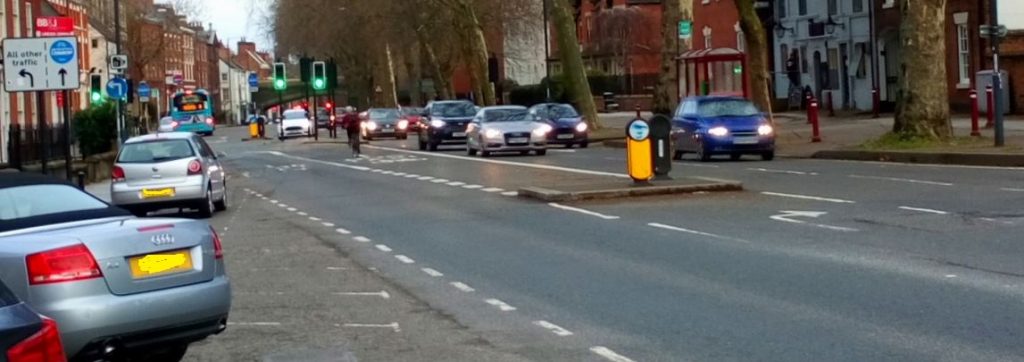
Object again to the removal of Friar Gate cycle lane as part of Derby’s Clean Air Strategy.
- Write again to DEFRA defra.helpline@defra.gsi.gov.uk (FAO Therese Coffey MP)
- Copy the minister responsible for Air Quality: therese.coffey.mp@parliament.uk
MPs can only respond to their own constituents, but they will be aware of other correspondence as well.
The Full Business Case for Derby’s Local Air Quality Plan has been submitted to DEFRA by Derby City Council.
- It barely mentions cycling. Sometimes cycling is most notable by its absence:
- Figure 3 (page 23) excludes details of the changes to the Friar Gate/Bridge Street junction, where the cycle lane is to be removed. Why would the city council want to hide the removal of a cycle lane from the public and DEFRA’s view?
- Section 2.4 (“Preferred Scheme”) also contains the following misleading point: “Changes … on Friar Gate to help provide alternative route choices”. On the contrary:
- The removal of the cycle lane will reduce the alternative choices open to many cyclists and many will stop cycling here altogether; many others who may have considered cycling will never start.
- As cycling should be a significant element in any long term air quality improvement strategy, this is a lamentable situation and the very words show that active travel has never been considered as part of this air quality plan; a shameful indictment.
- The lack of mention of cycling is in spite of the air quality consultation showing that people in Derby want better cycle routes
- The consultation for the three initial options showed that, from 2,537 responses:
- In Chart 4 (page 9) : 61.2% (4th highest) thought switching to lower emissions transport modes (such as cycling) can improve air quality.
- In Section 5.1.11 (page 9), the top 3 suggestions for how to tackle air quality issues included “more cycle lanes or an improved cycling infrastructure”.
- In Chart 5 (page 10): 31.7% of respondents (4th highest) use a bicycle as part of their current transport menu (this is omitted from the consultation summary, but the 6th highest (Train at 22.2%) is quoted instead! Why omit the statistics for cycling?
- In Chart 6 (page 11) 36.1% of respondenat (4th highest) said they would consider using a bicycle more to help improve air quality,
- However 16.3% of respondents who do not cycle said that poor infrastructure and safety concerns about riding on the road were barriers to them using their bikes.
- From the 189 responses to the final proposal consultation :
- 44% (4th highest) supported greater use of active travel investment and promotion (Chart 4, page 16)
- 41.7 % (5th highest) supported expansion of the e-bike share scheme (Chart 4)
- The most common “other comment” (17) called for increased cycling infrastructure.
- So why is the cycle lane on Friar Gate being removed? Removal runs contrary to what people in Derby say they want.
- The consultation for the three initial options showed that, from 2,537 responses:
The on-road cycle lane on Friar Gate is a cycle lane, and is an essential safety feature for all kinds of cyclists. It is the thing which enables most of those people cycling here to be there in the first place. The desires of so many people in Derby to have more cycling infrastructure must be upheld. The cycle lane must be retained or replaced with something different which gives the same or better continuity and directness of route AND, therefore, enables the route to be developed further in the future.
Object to the removal of Friar Gate cycle lane as part of Derby’s Clean Air Strategy.
- Write to DEFRA defra.helpline@defra.gsi.gov.uk (FAO Therese Coffey MP)
- Copy the minister responsible for Air Quality: therese.coffey.mp@parliament.uk
MPs can only respond to their own constituents, but they will be aware of other correspondence as well.
